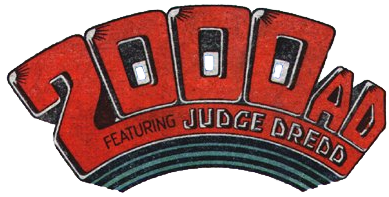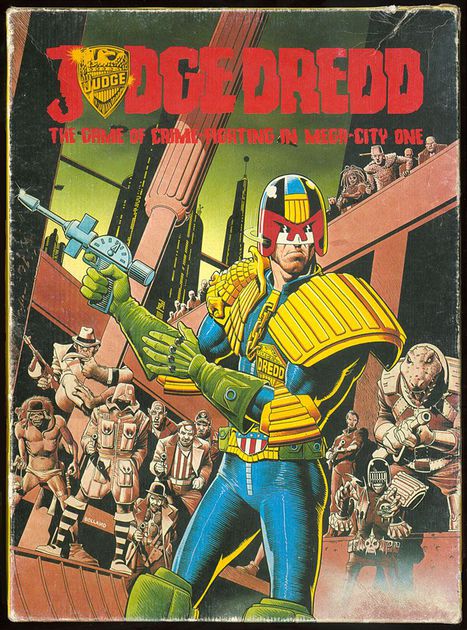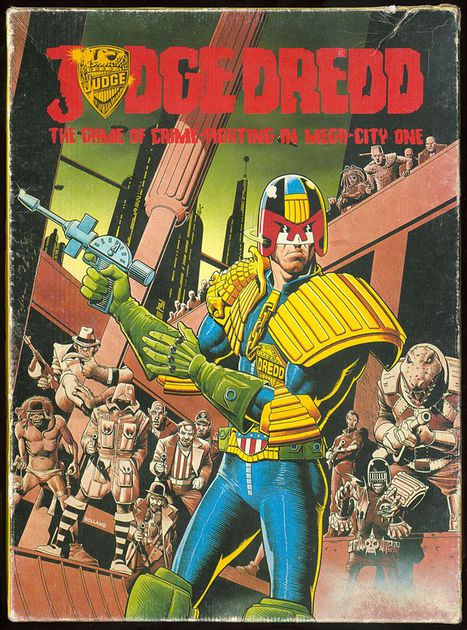

The box art is by Brian Bolland and shows a very colourful Dredd in blue, green and yellow (with little bits of fleshy pink and helmet red) in the midst of a sepia gallery of those he’s come up against, including Fink, Ratty, Rico, Don Uggie, the rest of the Angel Gang, Judge Death, Orlok, Grampus, Filmore Faro and Captain Skank.
I’ll first list the box contents in roughly the order listed on the back of the box – though I gather the original version which was released in 1982 had a few changes by the times I got my hands on a copy. By the time I bought my copy it was £9.95 direct from Games Workshop.
The board – my version is in four ‘jigsaw’ pieces, but from looking at pictures of the first edition boardgame on boardgamegeek I think the original 1982 version was one fold-out board.
Little cards (popped out from a sheet from what I can tell, and quite flimsy) for 28 ‘perp cards’, 28 ‘crime cards’, 21 ‘sector cards’, 6 ‘judge cards’ and 1 ‘turn marker’.
Bigger cards: 54 ‘action cards’
Six colourful playing pieces and a die – the original had ‘ludo’-style pieces and a plastic white die while mine is a little better
A rule booklet
A flavour booklet giving background on the perp, crime and sector cards
An ad for Games Workshop / Citadel Miniatures – about which more later
A raffle ticket so that if anything was missing I’d be able to contact Games Workshop and trace who was to blame (I prefer the little cards that Warlord include in their boxes).
The board by Ian Gibson shows a vaguely isometric projection of the Games Workshop version of Mega-City One. For game-play it’s split in to the sectors near Manhattan Island with each sector having one notable landmark. The only residential buildings shown are The Maze and Charles Darwin Block – the rest are filler background.
Perp cards grab pictures from Judge Dredd stories and are black and white except for the ‘combat value’ in red with the reverse in red and yellow.
Like the perp cards, crime cards pick artwork from stories that ran in the prog. They’re also black and white with a red combat value and the reverse in yellow and green.
The sector cards use black and white art taken from Ian Gibson’s board and the reverse is pink and blue.
The judge cards and turn marker are primarily designed to decide who goes first (and keep tabs on whose turn it is). They’re red and black on one side and consists of a judge badge (name: “JUDGE”) in a variety of colours matching up with the playing pieces. The turn marker is a Bolland Dredd telling the holder: “You’re first. So move it!”
The action cards are playing card sized and on good card. They’re also black and white while the reverse is a gold judge badge (name: “ACTION”) on a black background. They use art culled from the pages of Judge Dredd stories and have one effect that can be used and sometimes a second alternate effect that can be used instead.
The playing pieces in my set are small colourful judge figures in red, orange, yellow, green, blue and purple, plus a cheap plastic die. If I was going to guess a scale for the figures I’d say 15mm – 20mm or so. I usually dig out some better quality dice when I play this game to save each player stretching across the table or having to pass the die back and forth for every combat, but thought we’d try for the authentic “this is the only boardgame in the house and we don’t have any other dice” experience.
The rule booklet is an approximately A3 sheet of paper folded in half. The cover has a section of Ron Smith (and maybe Robin Smith’s) American Graffiti artwork while the next two and a half pages are the actual rules followed by half a page of credits and Games Workshop adverts. Notable credits are the actual designer, Ian Livingstone (famed for co-founding Games Workshop, the Fighting Fantasy range of gamebooks, Citadel Miniatures and being involved in Eidos’ publication of Tomb Raider) and playtesters including Steve Jackson (famous for some of the same things as Ian) and The Mighty Tharg (presumably Steve MacManus at this time). I’m pleased to report that I’ve met both of them at separate events and they’re both friendly and charming. The adverts plug other GW publications, including some which were licenced from other companies such as Runequest and Traveller – which will both appear much, much later in this blog. Something which will appear a bit sooner is White Dwarf.
The flavour text booklet is entitled Jack Caldwell’s Old-Fashioned Umpty Candy Card Album, is presented in the style of a bubblegum or cigarette card album and is completely superfluous as far as the game goes, but is a great added extra. It prints the fronts of every sector, perp and crime card, and includes a paragraph on the history or background of each card (Charles Darwin has a generic city-block description rather than a run-down of the Monkey Business storyline). That mention of cards reminds me of other places you could get collectable cards in the early eighties – I got gifted some which were given away with boxes of tea and I think they also came in some boxes of sweets including candy cigarettes.
Back to the game! Kind of. Instead of using the little plastic judges I got my RPG / wargaming miniature box out to see if we could use some judges from there. We didn’t end up using judges – Rackle used Toby the robot dog from Halo Jones and I used Ro-Jaws (both figures produced by Wargames Foundry, now discontinued).
I found the turn start card a bit of a clunky game mechanic – we could have just rolled the die, highest wins. Having a turn card to pass back and forth did help us keep track of whose turn it was though. Rackle went first and placed Toby at the Grand Hall of Justice while my Ro-Jaws figure went on the Justice Department Armoury.
I won’t go over all the rules, or give a blow-by-blow account of the game, but will mention the set up – the first player takes the top card from the sector deck then takes the top perp card and places that face down on the sector, followed by the top crime card, face up. We ended up with the following:
Item – Empire State Building, littering (1)
Item – Moonray Tower, scrawling (1)
Item – Otto Sump’s Ugly Clinic, mo-pad hijack (4)
Item – Smokatorium, murder – pussycat (6)
Item – Resyk, old comic selling (3)
Item – Alien zoo, stookie glanding (4)
The numbers in the brackets are the points on each card – the higher the number (combined with a similar number on the face-down perp card) the more difficult they are to defeat, but also worth more points at the end of the game.
It’s often said about this game that you can end up with Judge Death caught littering. This wasn’t the case this game – Sidney was doing some scrawling instead! The entire game took 2 hours, 17 minutes (I’d predicted it would take about one or two hours). Rackle got 84 points though was hampered by being halfway across the city from any perps during the last round while I had loads of cards I could throw at the most powerful perp on the table. So I won with 111 points.
General opinion seems to be that this game is best with 3-4 players but not so good with 2 players. We’d have to agree – it goes on too long with just two players – we’ve played it previously with more people and it’s faster moving while with only two people it takes a long time to plough through the perp deck. I also think that in a three or more player game you’d get more cards being played against other players and probably more of a tendency go to chasing perps before other judges can get to them.
Last but not least, the advert sheet. As I’ve mentioned, I bought this towards the end of Games Workshop’s 2000AD licence when they had a whole load of other products to push. This is another A3 sheet folded in two with printing in sepia for some reason (I’ve other Citadel / Games Workshop advertising sheets from the same era printed in more traditional black ink on white paper). On the front are ads for Judge Dredd: the Roleplaying Game, Judgement Day (a scenario for the Judge Dredd Roleplaying Game) and, uh, this boardgame. The centrespread has possibly the full range of Judge Dredd figures – loads of perps (many of which look pretty similar to one another), five fatties and three uglies. Citadel used a limited amount of the moulds to create a larger number of figures, so they can get fairly samey. More individually crafted are ten judges, Death, Dredd and Anderson, Dredd on a Lawmaster, the Angel Gang and Judge Child, Judge Cal and Henchmen, the other three Dark Judges, a Brit-Cit Judge, two Kleggs, six sky surfers and four more judges on lawmasters. The last page has the eight Rogue Trooper figures, then the RT boardgame and finishes with Judge Dredd: Slaughter Margin (JD RPG scenario). If you liked this blog post then you’ll be pleased to learn I have all the books and boxed sets mentioned here, so shall cover them (though I’m not sure exactly how I’ll cover the roleplaying games yet – any suggestions welcome).
Grailpage: Original art-wise there’s the box art and the map. I love maps so as good as Bolland’s cover is I’ll have to go for Gibson’s map.
Grailquote: there’s not a lot of original text in this other than the rules, but I think the following is new: “Not all aliens are Kleggs! Be nice to your neighbourhood alien, and he’ll be nice to you.”


10 thoughts on “Judge Dredd: The Game of Crime-Fighting in Mega-City One”